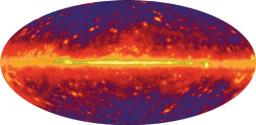Explosions pouring out as much energy in seconds as the sun does in its entire lifetime. Invisible beams of radiation sweeping across the sky like giant searchlights. Supermassive black holes emitting powerful and highly variable jets of radiation.

The universe truly looks different when viewed in gamma rays, the highest energies of the electromagnetic spectrum. And in early June, if all goes according to plan, NASA’s Gamma Ray Large Area Space Telescope, or GLAST, will be on its way to a ringside seat for observing these fireworks. From an orbit 565 kilometers above Earth, GLAST will see the gamma-ray sky with a breadth and clarity never before possible.
Every three hours, the observatory will re-examine every gamma-ray source in the sky, checking for bursts or any other changes.
“The fact that we’re going to be able to see the entire sky, all the time, with such a great improvement in sensitivity is incredibly important and cuts across many science topics,” says GLAST project scientist Steve Ritz of NASA’s Goddard Space Flight Center in Greenbelt, Md. Monitoring all of these gamma-ray sources for very long periods of time “is going to add a whole new dimension to understanding these objects.”
GLAST will also measure the abundance and location of gamma rays at energies from a few billion to 100 billion electronvolts — a range that had not previously been well observed by other gamma-ray detectors. “Historically, when you open up a new band of the electromagnetic spectrum in astrophysics, there are surprises,” Ritz says.
Because gamma rays in this range easily lose energy when they interact with ultraviolet and visible light, the relative abundance of these gamma rays is expected to provide new clues about the history of star formation in the universe. More speculatively, gamma rays with energies of about 100 billion electronvolts might also reveal the nature of dark matter, the invisible material that constitutes some 85 percent of all the matter in the universe. According to some models, when particles of dark matter meet, they annihilate and create gamma rays.
The observatory will also examine gamma-ray bursts — the short-lived outbursts that constitute the most powerful events since the Big Bang — across an unprecedented 7 orders of magnitude in energy. “If GLAST were a piano, it would have 23 octaves,” Ritz says.
“When you find out about all the things that GLAST can do,” Ritz adds, “it’s beautiful, and you just fall in love with all the science.”







